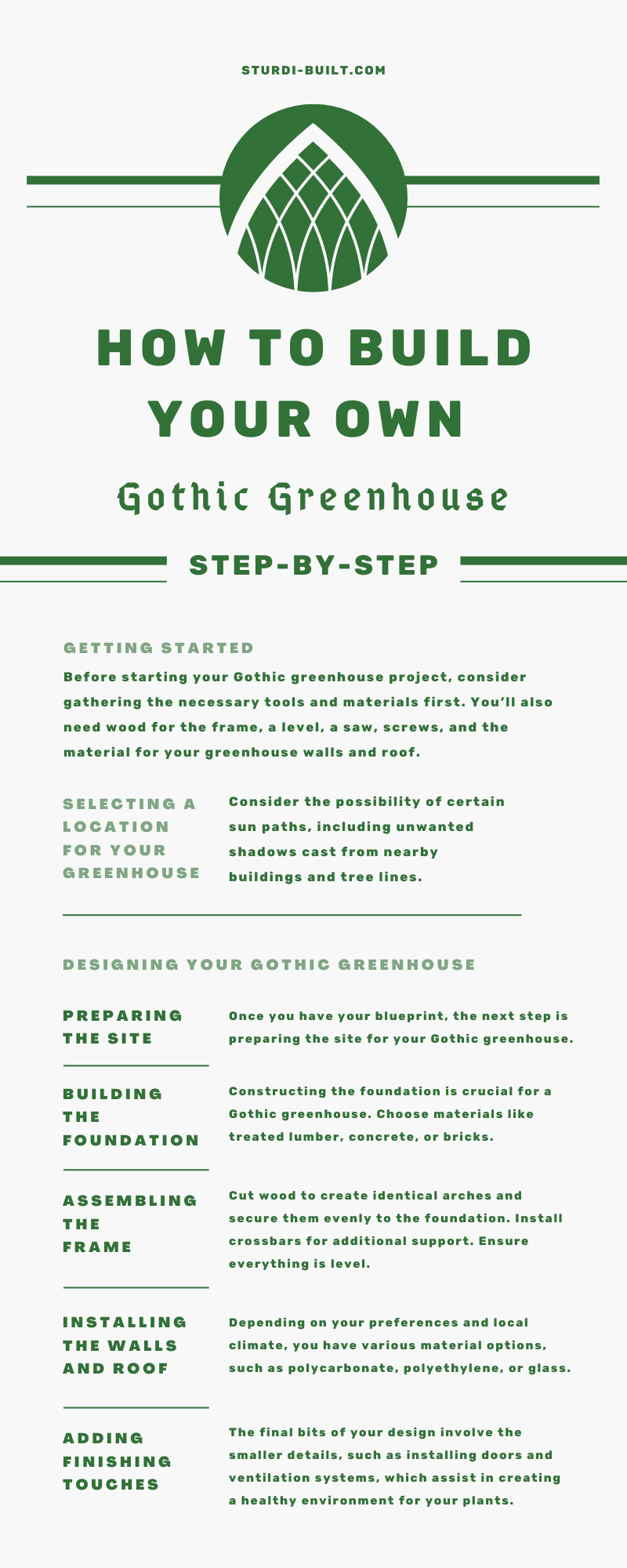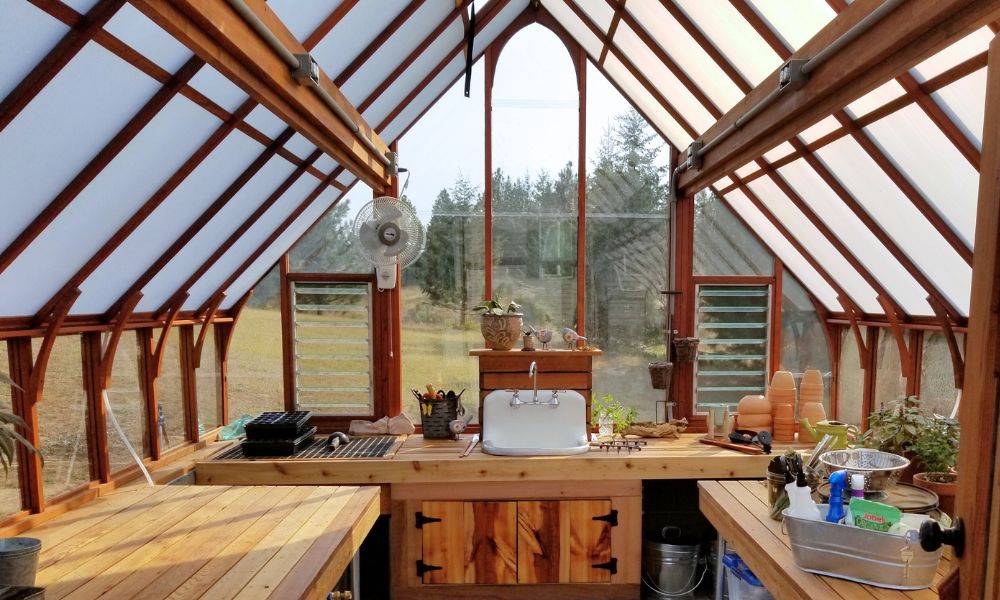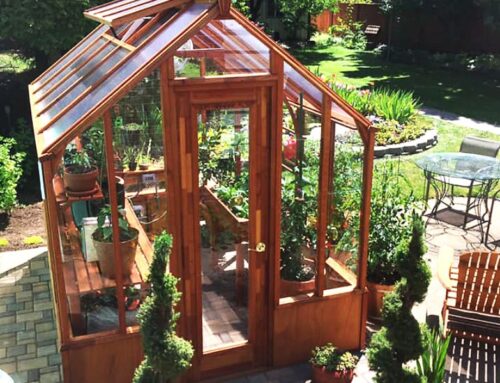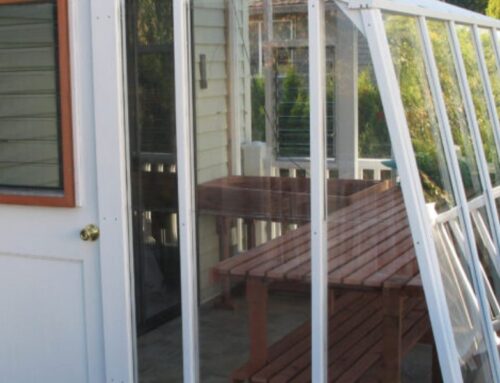A Gothic greenhouse stands the test of time for how it completes a home’s exterior. It’s the focal point of every home, and homeowners can build their own with this guide. The Gothic greenhouse lends an air of elegance while providing a practical solution for obtaining a structure that withstands snow and high winds. Our blog gives individuals the best information on how to build their greenhouses, step-by-step. Learn everything you need, from choosing a location to understanding Gothic architecture principles and building processes. Let’s create a warm, inviting place to go to amid the winter chill and a temperate climate for plants to grow year-long.
The Importance of a Step-by-Step Gothic Greenhouse Guide
A greenhouse is the best addition you could put in your backyard. Still, the greenhouse style you choose to build will require careful planning, a clear understanding of construction principles, and meticulous execution. And so, a complex design with a rigorous process, such as the Gothic greenhouse, makes having a directional guide indispensable. Give yourself a helping hand by reading our Gothic greenhouse step-by-step guide to break down any intimidating tasks into manageable sections.
Our guide goes through each stage, explaining what to do and how to obtain your end goal. It ensures you don’t overlook any crucial steps, minimizing mistakes that could compromise the stability and functionality of the greenhouse. This guide also imparts knowledge about the distinctive characteristics of Gothic architecture, enabling individuals to appreciate their greenhouse’s aesthetic beauty and structural advantages. Ultimately, our step-by-step guide provides a structured approach to building your Gothic greenhouse, enhancing the likelihood of successful completion, and paving the way for a fulfilling gardening experience.
Getting Started
Before starting your Gothic greenhouse project, consider gathering the necessary tools and materials first. You’ll also need wood for the frame, a level, a saw, screws, and the material for your greenhouse walls and roof.
Selecting a Location for Your Greenhouse
Selecting an ideal location for your greenhouse is the next step. The chosen spot should offer plenty of sunlight throughout the day, ideally facing south. Consider the possibility of certain sun paths, including unwanted shadows cast from nearby buildings and tree lines. Your plants will need ample sunlight to thrive, and if you plan to sit in there yourself, consider how much sun you’d want to enter in your seating area.
After selecting a location and gathering the essential materials, you can start designing your greenhouse!
Designing Your Gothic Greenhouse
Design is a huge part of building a Gothic greenhouse—strategy ensures the structure functions properly, not just to fit your home’s aesthetic. Check that your structural blueprints have optimal conditions for plants to thrive, including the appropriate roof size and style, since it helps make it suitable for colder climates.
Once familiar with these principles, personalize the greenhouse by determining its size, wall height, door and window placement, and other desired features. Be creative with the design, but ensure you align the structure to meet both specific needs and realistic stability and functionality.
Preparing the Site
Once you have your blueprint, the next step is preparing the site for your Gothic greenhouse. Clear the area thoroughly; remove vegetation, rocks, and debris, and then level the ground to create a flat surface. Ensure your fixed exterior is clear of rubble and debris if you have one. Mark the greenhouse’s boundaries using stakes and string. Now, you’re ready to move on to building the sturdy foundation and assembling the unique Gothic arch structure.
Building the Foundation
Constructing the foundation is crucial for a Gothic greenhouse. Choose materials like treated lumber, concrete, or bricks. Treated lumber is popular for its durability and resistance to rot and pests. Concrete is strong and long-lasting, while bricks add aesthetic charm. Dig a trench along the greenhouse boundaries, fill it with the chosen material, and secure lumber pieces to form a base.
Assembling the Frame
The frame is the backbone of the Gothic greenhouse. Cut wood to create identical arches and secure them evenly to the foundation. Install crossbars for additional support. Ensure everything is level.
Installing the Walls and Roof
Installing the walls and roof is a significant step in constructing your Gothic greenhouse. Depending on your preferences and local climate, you have various material options, such as polycarbonate, polyethylene, or glass. Polycarbonate is a popular choice due to its durability and insulation properties. Once you securely install the walls and roof, your greenhouse will take its final shape.
By following these steps, you’ll have a well-constructed, functional Gothic greenhouse that meets your gardening needs and adds an aesthetic touch to your backyard.
Adding Finishing Touches
Adding the final additions doesn’t mean adding decor to match the style of your Gothic greenhouse. The final bits of your design involve the smaller details, such as installing doors and ventilation systems, which assist in creating a healthy environment for your plants. Maximizing the space with shelves and planters also creates a thriving and more organized growing space.
Maintaining Your Gothic Greenhouse
Maintaining a Gothic greenhouse is crucial for its productivity. Regular cleaning and routine maintenance help identify issues so you can tackle them promptly before they disrupt the quality of life for your plants.
The best things to do for Gothic greenhouse maintenance are to keep the surfaces clean to maximize sunlight penetration, check for damage or wear and tear, and manage pests, humidity, and ventilation. You can extend the lifespan and optimize the functionality of your greenhouse by investing time in its maintenance.
Gothic Greenhouse Kits From Sturdi-Built
Building and maintaining a Gothic greenhouse is rewarding, but it takes time and effort. You not only gain a charming architectural feature to enhance your backyard’s style, but it’s also a gain for gardeners who desire a space for prolonged gardening.
With this comprehensive guide, we hope you have gained improved insight into how to build a Gothic greenhouse, step-by-step. Remember that this process can be time-consuming, but the results are well worth the time it takes to assemble your greenhouse. Imagine stepping into your greenhouse on a chilly winter day and being greeted by the sight and smell of thriving greenery.
Consider purchasing a Gothic greenhouse set from Sturdi-Built, made from the beautiful Redwood forests of Northern California, if you prefer a quicker option, such as pre-assembled Gothic high tunnel kits. Our kits have everything you need to assemble a Gothic greenhouse, making the process easier and faster. A Gothic greenhouse is a fantastic investment for any gardening enthusiast, whether you build it from scratch or a kit. Enjoy the process, watch your backyard boost your home’s aesthetic appeal and your gardening become more innovative throughout the year.











Leave A Comment